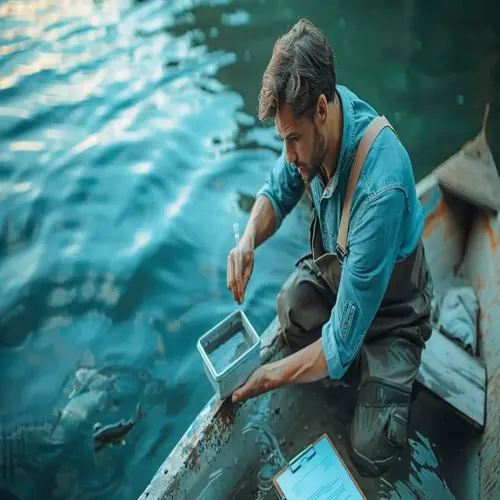Aquarium Filter Types: Your Essential Guide

Written by
Susan Taylor
Reviewed by
Prof. David Walsh, Ph.D.Common types of aquarium filters are sponge, HOB, canister, internal, and undergravel filters.
For breeding tanks less than 20 gallons and when less flow is ideal, it is good to use sponge filters.
HOB filters are great for 20-50 gallon community tanks.
Canister filters are designed for maximum filtration for large tanks larger than 50 gallons.
Chemical filtration media such as activated carbon should be replaced about every month to maintain effectiveness.
The flow rate of your filter should be matched with the needs of your species to prevent stress and ensure proper oxygenation.
Article Navigation
When contemplating aquarium filter types, it is easy to feel confused as to which one to buy if your aquarium water turns cloudy overnight. I remember my first betta tank and how quickly the water became muddy. This happens because each filter handles waste a little differently. We shall simplify that process.
Your fish deserve both clean water and stable conditions. This is a comprehensive discussion of the principles of filtration in simple language. The various types of filtering systems most commonly used in the hobby are analyzed, along with their respective maintenance procedures. Beginners will find a good starting point in the directives given. The experienced aquarist will discover some valuable tips towards optimization. Healthy aquariums begin with the proper filtration equipment selected.
Why Filtration Matters Least
Filter systems establish the foundation for aquarium health, but that is not the primary focus of this book. The alarming fact that 20% of aquarium failures can be attributed to neglect of the filter system should be taken into consideration. Fish suffer if toxins build up. Without the movement of water, the oxygen content drops. Therefore, the above essentials must be discussed first.
Your aquarium filter has two major functions. It removes toxic ammonia from fish waste by using biological means. It also aerates the water and increases the surface agitation. These functions allow for good breathing for the fish. Simple sponge filters do this easily. More elaborate systems do it better. Never overlook these basic principles.
Various aquarium filter types build upon these foundational ideas differently. Sponge filters gently aerate. Canister systems use strength for toxin elimination. Realizing how each type deals with fundamentals aids in wise choosing. We now explore these differences, thus, to aid your specific setup needs.
Toxin Elimination
- Converts harmful ammonia from fish waste into less toxic nitrates through beneficial bacteria, preventing poisoning and fish fatalities.
Water Clarity Maintenance
- Removes visible debris like uneaten food and plant matter through mechanical filtration, keeping water visually clear and reducing algae growth.
Oxygenation Support
- Promotes gas exchange at the water surface through circulation, maintaining dissolved oxygen levels between 6-8 ppm for healthy fish respiration.
pH Stabilization
- Prevents dangerous pH swings by processing acidic compounds, keeping levels stable within the ideal 6.5-7.5 range for most freshwater species.
Bacteria Colonization
- Provides surface area for nitrifying bacteria to break down 0.25-0.5 ppm of daily ammonia waste, completing the nitrogen cycle.
Chemical Filtration Basics
Chemical filtration acts like a sponge for impurities in your aquarium water. Special materials, such as activated carbon, contain microscopic pores that trap dissolved substances. Think of tiny magnets pulling tannins or medications from the water. This adsorption process targets what mechanical filters miss.
Different media serve different purposes. Suppose you want to remove medicines from the tank after you have treated the fish, use activated carbon. It lasts about 3-4 weeks before it gets saturated. Purigen resins need to be used if you desire clear water that has become yellowed. These resins can be regenerated in a bleach solution. Removers for phosphates also help combat algae in planted tanks.
Limit the use of chemical filtration to special circumstances. Operating carbon at all times strips the beneficial trace minerals from the water. It tends to upset the natural balance of the tank. I use it only in emergencies, such as clearing medications. Whenever possible, closely monitor the water parameters during use to avoid instabilities.
Activated Carbon
- Adsorption Power: Removes tannins, medications, and chlorine through microscopic pores that trap impurities like a sponge.
Ion-Exchange Resins
- Targeted Removal: Specialized resins like Purigen attract specific ions such as ammonia or heavy metals from tap water.
Phosphate Removers
- Algae Control: Granular media reduces phosphate levels below 0.03 ppm to prevent excessive algae blooms in planted tanks.
Ammonia Absorbers
- Emergency Use: Zeolite minerals temporarily absorb ammonia spikes during tank cycling or quarantine situations.
Polymer Filtration
- Multi-Functional: Synthetic polymers like Chemi-Pure combine chemical and biological filtration in one media pouch.
Internal Filters Simplified
Internal filters provide a smaller form factor, which is nice for limited spaces. The size is helpful for nano tanks, but it reduces media. I utilize them in my betta tanks because space is limited. They are internally operated, which means fewer external apparatus. This simplicity comes with trade-offs.
They work best in tanks that are 10 gallons or less. They have a limited power supply for larger tanks. On the other hand, an external filter will require less frequent cleaning. An internal filter will clog up faster with debris and needs to be cleaned every week. This difference in maintenance will significantly impact your schedule.
Real-life applications are realized in specific situations. I use internal filters for quarantine tanks isolating sick fish. They have a mild current that suits bettas that prefer a gentle current. They are also useful when setting up hospital tanks for temporary periods. Just remember, their biological filtration capabilities are limited.
Undergravel Filters Revisited
Under-gravel filters are an ancient method of filtration in aquaria that has gone out of favor. The water is drawn through the gravel bed, where it passes through biological filter media. This was, at one time, the dominant method of filtration for home aquaria, although it has serious drawbacks these days.
The gravel serves as the actual filter medium, which is home to the beneficial bacteria. The water washes down through the gravel into the uplift tubes. This is a biological filter, but it often contains detrimental anaerobic pockets, which result from anaerobic bacteria breaking down organic compounds in this zone. The poisonous hydrogen sulphide gas is produced in these areas.
Modern filter technologies have surpassed undergravel methods to such an extent that any justification for their continued use is now considered ludicrous. Sponge filters provide safe biological filtration without the problems associated with substrate contamination. Canister filters are far superior in mechanical cleaning. Modern techniques permit the use of live plants, which, in undergravel systems, tend to be uprooted and killed during the general cleaning process.
I might still consider them, but only as simple fish-only setups with no plants. They are also used by some breeders in bare tanks for the grow-out phase. They require careful gravel vacuuming to prevent the accumulation of toxic substances. They are also, however, less reliable than more modern substitutes for long-term success.
Core Filter Types Compared
Let's examine three types of modern mechanical filters which are most common: sponge filters, Hang On Back filters and canisters. Sponge filters are the least expensive, costing $10 to $20 per filter. They are ideal for situations where a tank has no more than 20 gallons capacity. The maintenance requirement for sponge filters is low, and the rate of filtration is medium. Hang On Back filters, or HOBs, are much more expensive, ranging in the $30-60 range at present. They work well in tanks having 20-50 gallons. Canisters vary in price from $80-200, and which, therefore, can be used with tanks of over 50 gallons. Maintenance requirements are quite high.
Each has its best application. Sponge filters should be used for breeding tanks to protect sensitive fry. The 50-100 GPH flow is so gentle that baby fish are not harmed. Hang-On Back units are better suited for community tanks that house tetras, guppies, or similar species. The 150-300 GPH flow will aerate the water without being disruptive to the size residents.
Canister filters are a must in large cichlid tanks or reef setups. They produce enough flow at 400-800 GPH to handle the heavy bioloads. No internal filter works well in quarantine tanks or betta setups that are less than 10 gallons. Remember, no 'best' filter is the same for all. You individualize based on tank size, the inhabitants you desire, and the amount of time you are willing to devote to maintenance.
5 Common Myths
Filters eliminate the need for regular water changes in aquariums
Filters process toxins but cannot remove accumulated nitrates, which require dilution through partial water changes. Performing 25-30% water changes weekly remains essential to maintain safe nitrate levels below 20 ppm and replenish vital minerals for fish health and immune system function.
Higher flow rates always guarantees better filtration performance for all species of fish.
Fitness programs take into account the sluggishness of species like bettas or gouramis, who prefer a quiet, scentless environment. Efficient filtering includes the removal of mechanical wastes by biological methods, with a volume of 4-5 tank volumes of water turned in one hour. Trying to cater to the flow demands of species in their natural habitat is the best method of avoiding the stress involved with filtration and at the same time holding the wastes and the oxygen at a good level.
Nutrient-eating bacteria live everywhere that is not the filter media
Nitrifying bacteria inhabit most any surface, including the substrate, decor and the roots of the plants. While the filter concentrates the bacteria, the eliminations that would be made by destroying it would still leave some 60-70% of the biological filtering system intact. This outlying colonization gives the system its resilience in times of filter cleansing or during outages of power.
Chemical filter media are utilized indefinitely without replacement or regeneration
Activated carbon becomes saturated within 3 or 4 weeks and can release thitherto removed pollutants back into the water column. Ion-exchange resins (like Purigen) become ineffective after so much water flowing through them "processing" certain contaminants. Monthly replacement or regeneration of these products precludes sudden and drastic changes in water parameters and establishes a more consistent purification process for aquatic health.
The filter media needs replacing monthly to keep the filters working efficiently
Biological media (ceramic rings) have necessary bacteria living in them, which mean they should not be fully replaced. Only the mechanical pads, which are clogged with dirt, need replacing, and biological media rinsed in tank water retains the nitrogen cycle. Removing all media at the same time will disrupt the biological filtration and potentially give ammonia spikes.
Conclusion
Your outstanding filter choice entirely depends on how big your tank is, the fish you want to keep in the tank, and the amount of waste they produce. Small tanks with bettas are well-suited for a sponge filter. Large cichlids require a canister filter. Consider what type of fish you have and how much water current they prefer, as well as what maintenance they can tolerate, before making your decision.
I note the underlying principles to balance mechanical, biological, and periodic chemical filtration correctly. Routine cleaning is essential to avoid toxin development. I clean the ceramic sponge filters weekly, but only rinse the canister media water every month. Consistency leads to stable water parameters, which help maintain fish health.
Start easy if you are a beginner! Sponge or Hang-on-Back filters are easy to run and forgiving. Learn these before upgrading. My first community tank had a HOB filter, which I ran for years before eventually upgrading to canister filters. Get confidence built with reliable basics first.
With your expertise now complete, you have sustainable aquatic homes. Select filters that suit your specific needs, taking into account their maintenance requirements. The fish will thrive in the wonderful water. Confident in your knowledge and experience, enjoy the rewards of the aquarium venture.
External Sources
Frequently Asked Questions
What are the main types of aquarium filters?
The primary aquarium filter types include sponge filters, Hang On Back (HOB) filters, canister filters, internal filters, and undergravel systems. Each serves different needs:
- Sponge: Gentle flow for small tanks and sensitive species
- HOB: Versatile for mid-sized community tanks
- Canister: High-capacity for large aquariums
- Internal: Compact solutions for nano setups
- Undergravel: Legacy systems with significant limitations
How do I select the right filter for my tank?
Consider these key factors when choosing an aquarium filter: tank size, fish species, maintenance requirements, and filtration capacity. Match the filter's flow rate to your inhabitants' needs, calm fish like bettas need low-flow options while cichlids tolerate stronger currents. Also evaluate biological load and available space.
Can aquarium filters be too powerful?
Yes, excessive flow stresses fish adapted to calm waters like bettas or gouramis. Strong currents force fish to swim constantly, deplete energy reserves, and inhibit natural behaviors. Optimal flow balances debris removal with species comfort, typically 4-5 times tank volume turnover hourly.
Do filters eliminate water changes?
No, filters process toxins but cannot remove dissolved nitrates or replenish minerals. Regular partial water changes remain essential to:
- Dilute accumulated nitrates below 20 ppm
- Restore calcium and magnesium levels
- Remove organic waste bypassing filtration
- Maintain stable pH and water hardness
What's the difference between mechanical and biological filtration?
Mechanical filtration physically traps debris like uneaten food, while biological filtration uses beneficial bacteria to break down toxic ammonia and nitrites. Most filters combine both, but biological media like ceramic rings should never be fully replaced to preserve essential bacteria colonies.
How often should filter media be replaced?
Replacement frequency varies by media type:
- Mechanical pads: When clogged, typically monthly
- Chemical media (carbon): Every 3-4 weeks
- Biological media: Rinse in tank water, never fully replace
- Filter floss: Replace weekly for optimal clarity
Are sponge filters sufficient for large aquariums?
Sponge filters work best for tanks under 20 gallons. Their gentle flow protects fry and shrimp but lacks capacity for larger bioloads. For bigger setups, combine sponge filters with Hang On Back or canister systems to enhance biological filtration without excessive current.
Why use chemical filtration media?
Chemical media targets specific impurities through adsorption:
- Activated carbon: Removes tannins, medications, chlorine
- Phosphate removers: Prevent algae blooms
- Ion-exchange resins: Capture heavy metals and ammonia
- Note: Chemical media requires monthly replacement
Can multiple filters benefit an aquarium?
Yes, pairing filters enhances filtration redundancy and flow distribution. Combining a sponge filter with a Hang On Back unit provides backup biological filtration during maintenance. For large tanks, dual canisters improve water turnover while creating balanced current patterns.
Do undergravel filters still have value?
Undergravel systems are largely outdated due to maintenance challenges and anaerobic risks. While they offer biological filtration through substrate, modern alternatives provide superior oxygenation and easier upkeep. They're only suitable for simple, plant-free setups with frequent gravel vacuuming.

